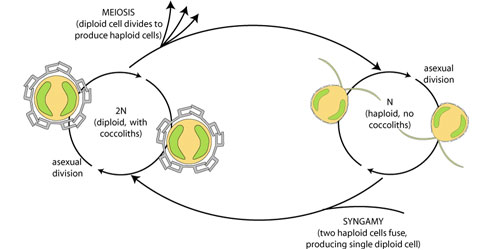Reproduction and lifecycle
The most common mode of reproduction in E. huxleyi and other coccolithophores is asexual binary fission. One cell divides in two, by mitosis, producing two identical daughter cells.
If nutrient elements and light are abundant then E. huxleyi cells will divide about once a day, allowing very rapid population growth (Paasche et al., 2002). Under less favourable conditions, however, a single cell can survive without reproducing for several weeks at least.
In addition, E. huxleyi has a dimorphic lifecycle with alternation of a diploid phase (with two copies of each chromosome) and a haploid phase (with one copy of each chromosome). This alternation of phases, via meiosis and syngamy, allows genetic recombination and maintains diversity.
The diploid phase is non-motile and forms the distinctive coccoliths. The haploid phase is motile, it has two flagellae which allow it to swim. In E. huxleyi, this phase does not produce coccoliths, but does produce cellulosic scales. An unusual feature of coccolithophores which is shared by E. huxleyi is that both the haploid and the diploid phase can reproduce asexually so that the one species can exist indefinitely in either of two forms.
